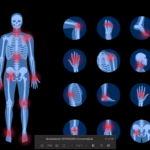
BLACKDAYutterstock.com
Palindromic rheumatism (PR) was first described in 1944 as “unique in its nature of recurrent, transient episodes of excruciatingly painful inflammation of articular and periarticular tissues, followed by periods without symptoms.”1 Unfortunately, it is becoming evident this entity is more frequent than we thought.2
PR is easily ignored or misdiagnosed due to its character (i.e., no symptoms or signs between attacks) and because patients usually present after resolution of symptoms, with no evidence of acute inflammation on clinical, serologic or radiologic examination.
An experienced rheumatologist obtaining a focused history usually finds it necessary to diagnose PR. In a 1987 study, Hannonen et al. proposed this diagnostic criteria: 1) recurrent attacks of sudden-onset mono- or polyarthritis, or of a periarticular tissue inflammation, lasting from a few hours to one week; 2) verification of at least one attack by a physician; 3) subsequent attacks in at least three different joints; and 4) exclusion of other forms of arthritides.3
We have observed over the years in a large rheumatology practice the difficulty of obtaining a focused history necessary to suspect and diagnose PR, and the difficulty patients, family and referring doctors have had with accepting the diagnosis. We also noted the evolution of patients with PR to severe forms of rheumatoid arthritis (RA) was more common than expected and that these patients suffered from particularly severe RA.
Below, we describe two such cases.
Case No. 1
A 60-year-old Hispanic male presented with acute onset pain of the right wrist attributed to mild trauma. This resolved spontaneously over the course of a few hours. Pain and swelling resurfaced two weeks later, however, this time in his left elbow. Conservative measures were taken, and symptoms of pain, swelling and redness subsided within 36 hours.
Over the course of the next two months, the patient experienced intermittent episodes of abrupt onset, excruciating pain at various joints (usually one to three joints simultaneously). These episodes lasted 10–40 hours and subsided almost as abruptly as they started. Naproxen helped ease the pain.
The patient was seen by an internist during one such flare, and lab tests, which included complete blood count (CBC), erythrocyte sedimentation rate (ESR), C-reactive protein (CRP), uric acid and thyroid stimulating hormone (TSH), were normal.
Three months later he presented to a rheumatologist with persistent pain in his right wrist and metacarpals (MCPs) associated with morning stiffness. A focused history revealed the absence of trauma (although the patient kept blaming nonexistent “possible” trauma because there was swelling and pain). Further investigation revealed a positive rheumatoid factor (RF), anti-cyclic citrullinated peptide (anti-CCP) and elevated CRP. Joint X-rays proved unremarkable. Given these more classical signs of RA, he was treated with hydroxychloroquine, methotrexate, naproxen and low-dose prednisone.
Nine years later, he required increasing doses of prednisone, and he developed rheumatoid nodules, dyspnea on exertion and fatigue. He was subsequently hospitalized for a deterioration of hypoxemic respiratory failure with pulmonary infiltrates seen on imaging. Two weeks later he died from respiratory failure.
Case No. 2
A 72-year-old man, the brother of the aforementioned patient with a history of membranous nephropathy, controlled with cyclosporine, and celiac disease, presented with an episode of acute right knee pain, swelling and warmth. Symptoms resolved spontaneously.
He then developed multiple episodes of intermittent tenderness, stiffness and weakness of both carpometacarpals (CMC) and MCPs, which resolved with deep massage and heat. There were also numerous episodes of abrupt onset, intense pain occurring in several joints (especially the shoulders) that worsened with movement, occurred mainly at night and lasted 24–36 hours.
The patient was diagnosed with osteoarthritis with cervical radiculopathy due to the variability of his symptoms, no joint findings and X-ray evidence of cervical spondylosis. Symptoms improved with conservative measures, including swimming and physical therapy.
Ten months after the initial episode, he had a more intense presentation of acute left shoulder pain. An ultrasound revealed severe inflammation, mostly in tendons. Serologies were suggested, but not obtained.
A year later, similar symptoms developed in his right shoulder, with the subsequent rupture of the long head tendon of his right bicep. This led to his first encounter with a rheumatologist. The exam revealed RA joint changes in both hands and positive RF and anti-CCP, confirming the diagnosis.
He was started on hydroxychloroquine sulfate, methotrexate, naproxen, low-dose prednisone and cyclosporine. Eighteen months later, he developed rheumatoid nodules and a skin rash compatible with RA vasculitis. Cyclosporine was discontinued, and adalimumab was used briefly, but not tolerated; currently he is on rituximab with good response.
Discussion
It remains controversial whether PR represents a spectrum of RA or is a completely separate entity. With similarities of positive RF serology, anti-citrullinated peptide/protein antibodies (ACPA) and the evolution of many of these patients to chronic, erosive diseases, such as RA, more questions than answers prevail.4,5
It remains unclear what prognostic factors predict which patients will go on to develop malignant RA and which will remain in prolonged remission. Understanding this may be key in the early, targeted management of patients at risk to avoid chronic, debilitating disease.
The ultimate treatment strategy also remains unclear, although several reports have shown a good response to NSAIDs and antimalarial drugs, possibly delaying chronic arthritis.6
Amaka Odonwodo, MD, MPH, recently completed her internal medicine residency at the Cleveland Clinic at Fairview Hospital in Cleveland. She is interested in rheumatology as a career path.
Carlos Julio Aponte, FACP, FACR, graduated from the National University of Colombia in 1968. He completed internal medicine residency in Cleveland, Ohio, and a rheumatology fellowship at the Cleveland Clinic. From 1975–2013, he practiced rheumatology mostly at Fairview Hospital in Cleveland, where he was chief of the Rheumatology Section of the Department of Medicine. His present title is chief of rheumatology emeritus. He continues to teach in many countries, most recently in Cambodia with Health Volunteers Overseas.
References
- Guerne PA, Weisman MH. Palindromic rheumatism: Part of or apart from the spectrum of rheumatoid arthritis. Am J Med. 1992 Oct;93(4):451–460.
- Salvador G. Gomez A, Vinas O. Prevalence and clinical significance of anti-cyclic citrullinated peptide and antikeratin antibodies in palindromic rheumatism. An abortive form of rheumatoid arthritis? Rheumatology (Oxford). 2003 Aug;42(8):972–975.
- Hannonen P, Müttönen T, Oka M. Palindromic rheumatism: A clinical survey of sixty patients. Scand J Rheumatol. 1987 Mar;16(6):413–420.
- Sanmarti R, Cabrera-Villalba S, Gomez-Puerta JA, et al. Palindromic rheumatism with positive anticitrullinated peptide/protein antibodies is not synonymous with rheumatoid arthritis. A longterm followup study. J Rheumatol. 2012 Oct;39(10):1929–1933.
- Cabrera-Villalba S, Sanmartí R. Palindromic rheumatism: A reappraisal. Int J Clin Rheumatol. 2013 Oct;8(5):569–577.
- Gonzalez-Lopez L, Gamez-Nava JI, Jhangri G, et al. Decreased progression to rheumatoid arthritis or other connective tissue diseases in patients with palindromic rheumatism treated with antimalarials. J Rheumatol. 2000 Jan;27(1):41–46.


